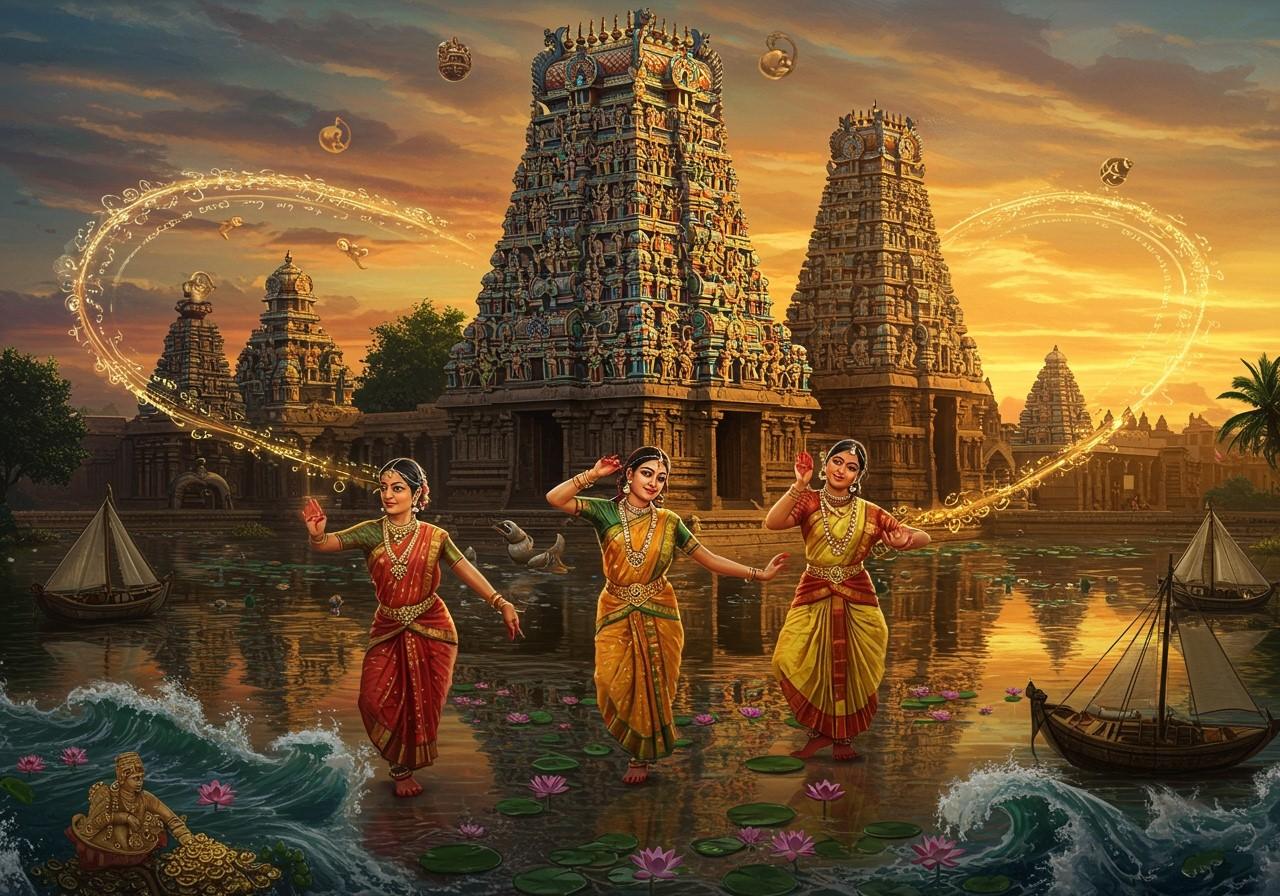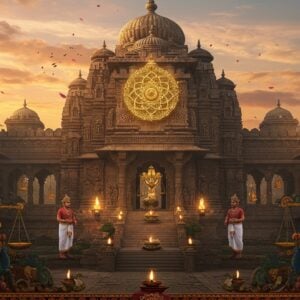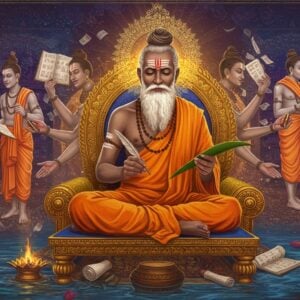
The Pandyan Dynasty, renowned for its resilience amidst challenges, significantly shaped Tamil Nadu’s culture and traditions. Flourishing particularly during the Sangam Age, they were strong patrons of Tamil literature and Vedic traditions, holding Brahmans in high esteem. Their influence waned after the Kalabhras’ invasions, yet their contributions to Hinduism and the spread of Buddhism, especially to Sri Lanka, left a lasting mark on trade networks and cultural exchange.
The Pandyan Caste System
The caste system during the Pandyan rule was a complex social structure. While the Pandyas themselves belonged to the Kshatriya (warrior) caste, the hierarchy encompassed various groups:
- Brahmins: Priests and scholars held the highest position, revered for their knowledge and spiritual authority. They played a crucial role in religious ceremonies and advising the rulers.
- Kshatriyas: The warrior class, including the ruling Pandyan dynasty, focused on protecting the kingdom and maintaining order. They upheld dharma and ensured the welfare of their subjects.
- Vaishyas: Traders and merchants formed the backbone of the economy, engaging in commerce and contributing to the kingdom’s prosperity. They facilitated trade within the region and with other lands.
- Shudras: Laborers and service providers constituted the largest segment of society, performing essential tasks that supported the functioning of the kingdom. Their contributions were vital to daily life and economic activity.
This system impacted social mobility, with limited opportunities for movement between castes. Tamil literature, particularly Sangam poetry, offers glimpses into the dynamics of this hierarchy. Temples, central to Pandyan society, served to reinforce these social structures while also integrating diverse communities within the overarching system.
Local Cuisines of the Pandyan Era
The Pandyan culinary traditions were diverse and reflected the region’s agricultural abundance. Staple ingredients included rice, lentils, and millets, while the flourishing trade introduced spices like pepper, cardamom, and cinnamon, enriching the culinary landscape. Popular dishes included:
- Pongal: This celebratory rice dish, cooked with lentils and spices, remains a cherished part of Tamil cuisine, often prepared during festivals and special occasions.
- Adai: A savory lentil pancake, Adai is a nutritious and flavorful dish, still enjoyed in Tamil Nadu today, often served with chutney or sambar.
Food played a central role in religious and social ceremonies, highlighting its cultural significance. Women held a vital role in preserving and transmitting culinary knowledge across generations, shaping the culinary heritage of the region.
Festivals in the Pandyan Kingdom
Festivals during the Pandyan reign were grand occasions deeply rooted in religious and cultural traditions. Major festivals included:
- Navaratri: This nine-night festival honoring the goddess Durga was a time of vibrant celebrations, including music, dance, and storytelling, fostering community bonding and cultural continuity.
- Deepavali: The festival of lights, symbolizing the victory of good over evil, was celebrated with illumination, fireworks, and festive gatherings, signifying hope and renewal.
- Pongal: A harvest festival dedicated to the sun god, Pongal involved the ceremonial cooking of rice and offerings of thanks for a bountiful harvest, reinforcing the connection to agriculture.
These festivals, often centered around temples, strengthened community ties and cultural continuity. Artistic expressions like dance, music, and theatrical performances flourished during these celebrations. The architecture of temple gopurams (towers) and mandapams (halls) played a significant role in festival rituals. These traditions, aligned with the agricultural calendar, also had a notable impact on the local economy.
Pandyan Art and Architecture
The Pandyan Dynasty is celebrated for its remarkable contributions to art and architecture. Distinctive features included:
- Use of Granite: The extensive use of granite in temple construction demonstrated the Pandyas’ mastery of stonework and their commitment to creating enduring structures. This choice of material contributed to the longevity and grandeur of their architectural marvels.
- Intricate Carvings: The elaborate carvings adorning temple walls, pillars, and gopurams showcase the exceptional skill of Pandyan artisans. These intricate details depict deities, mythical creatures, and scenes from epics, adding to the artistic richness of the temples.
Landmarks like the magnificent Ashtabhuji Temple and the iconic Meenakshi Amman Temple in Madurai exemplify their architectural prowess. Temple construction served not only as a testament to their devotion but also as a catalyst for religious and cultural practices. The Pandyas’ patronage of the arts led to the flourishing of sculpture, painting, and literary works like the Thirukkural and Sangam poetry.
Social and Economic Structures
The Pandyan socio-economic structure was multifaceted. Agriculture thrived due to advancements in irrigation, ensuring a stable food supply and supporting the growing population. Trade, particularly maritime commerce, played a crucial role in economic prosperity. Key trade routes facilitated the exchange of commodities like spices and textiles, connecting the Pandyan kingdom with other regions and contributing to its wealth.
Governance policies further stimulated economic development, creating a favorable environment for trade and agriculture. Social structures were influenced by a combination of factors, including geographical location, trade networks, and agricultural practices, shaping the social fabric of the kingdom.
Poojn.in: Connecting to Pandyan Heritage
Poojn.in, India’s leading online store for cultural and religious goods, offers a wide selection of products that resonate with the rich traditions of the Pandyan era. Explore our collection:
- Traditional Clay Pots: Discover handcrafted clay pots, reminiscent of those used in ancient Pandyan kitchens, perfect for preparing traditional dishes and adding a touch of authenticity to your culinary practices. These high-quality pots are available in various sizes and designs.
- Puja Items: Enhance your spiritual practices with our curated selection of puja items, including brass lamps, incense holders, and traditional ritual accessories. These items are crafted with meticulous attention to detail, reflecting the reverence and artistry of the Pandyan era.
- Explore More: Discover a wider range of products related to temple worship, home rituals, and festive celebrations. Poojn.in is your one-stop destination for all your cultural and religious needs, connecting you to the rich heritage of India.
Conclusion
The Pandyan Dynasty’s enduring legacy is evident in the rich tapestry of Tamil Nadu’s cultural heritage. From intricate social structures to vibrant culinary traditions and elaborate festivals, the Pandyas have indelibly shaped the region’s identity. Their contributions to art, architecture, and economic development continue to inspire and influence contemporary practices. Understanding the Pandyan Dynasty offers valuable insights into the historical and cultural evolution of South India, fostering a deeper appreciation for its enduring traditions.


